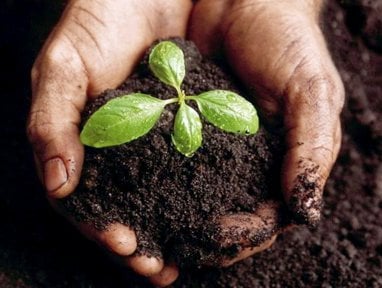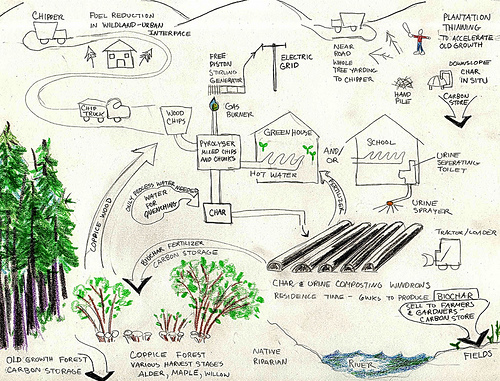(Making an own article on biochar, as per Chriswaterguy's wish) |
(→Charcoal/biochar in the Appropriate Technology context: moved info from this article to charcoal page) |
||
| Line 33: | Line 33: | ||
(image from Flickr user '''visionshare''' by CC license) | (image from Flickr user '''visionshare''' by CC license) | ||
==== List of uses of biochar==== | |||
==== List of | |||
*Inexpensive soil amelioration for degraded land (i.e. biochar as a liming agent) | *Inexpensive soil amelioration for degraded land (i.e. biochar as a liming agent) | ||
*Need less land = lower startup costs for a Sustainable Village | *Need less land = lower startup costs for a Sustainable Village | ||
| Line 55: | Line 45: | ||
*Biochar for sale as a source of income for an emerging community | *Biochar for sale as a source of income for an emerging community | ||
*Combine with solar thermal heat source to make a ''solar pyrolysis unit'' for charcoal production | *Combine with solar thermal heat source to make a ''solar pyrolysis unit'' for charcoal production | ||
=== Suitable feedstocks === | === Suitable feedstocks === | ||
Revision as of 14:00, 3 August 2012
Biochar is a name for charcoal when it is used for particular purposes, especially as a soil amendment.
Overview
Note: This page was transwikified from Open Source Ecology - please help adapt it to Appropedia.
According to the International Biochar Initiative:
Biochar is a fine-grained charcoal high in organic carbon and largely resistant to decomposition. It is produced from pyrolysis of plant and waste feedstocks. As a soil amendment, biochar creates a recalcitrant soil carbon pool that is carbon-negative, serving as a net withdrawal of atmospheric carbon dioxide stored in highly recalcitrant soil carbon stocks. The enhanced nutrient retention capacity of biochar-amended soil not only reduces the total fertilizer requirements but also the climate and environmental impact of croplands. Char-amended soils have shown 50 - 80 percent reductions in nitrous oxide emissions and reduced runoff of phosphorus into surface waters and leaching of nitrogen into groundwater. As a soil amendment, biochar significantly increases the efficiency of and reduces the need for traditional chemical fertilizers, while greatly enhancing crop yields. Renewable oils and gases co-produced in the pyrolysis process can be used as fuel or fuel feedstocks. Biochar thus offers promise for its soil productivity and climate benefits.
Some of the world's most productive soils (e.g. Canadian prairies, Russian Chernozem / or "black earth") are very rich in organic carbon. This is now thought to be pyrogenic in origin, likely originating from prairie or forest fires. This carbon is often thousands of years old, demonstrating its stability in soil. For more extensive background on Biochar, please consult the Wikipedia entry on biochar.
Production
The pyrolysis temperature appears to be a critical factor determining char yield vs. energy yield (tradeoff). Flexi-pyrolysis units are being developed that can be set for either char yield or gasification yield. Dry biomass can be pyrolyzed at regular atmospheric pressure. For wet biomass, pyrolysis at higher pressure ("supercritical") may be necessary, requiring a more sophisticated technical set-up.
When large chunks of wood are used as feedstock, the charcoal may need to be crushed before use (beware: coal dust explosion !). Many agrigultural feedstocks and leaf litter will not need to be pulverized but will readily break into smaller pieces by themselves. For information on small-scale gardening, please consult the Gardening with Biochar FAQ, an excellent resource.
Biochar as a method of carbon sequestration
The earth absorbs around 18 times the amount of carbon emitted by humans each year.[verification needed]W However, about the same amount (one figure given is 99.9%) of this carbon is released to the atmosphere through decomposition. This cycle can be closed by a process known as pyrolysis, in which biomass is heated in the absence of oxygen, creating charcoal and locking carbon in the form of biochar.W
Locking carbon away from the atmosphere and the carbon cycle described is referred to as carbon sequestration. Biochar can potentially lock away carbon carbon for hundreds or even thousands of years. If a real commitment were made, massive reductions in atmospheric carbon could be achieved - locking down carbon emissions and increasing the wealth of our soils. In conjunction with other geoengineering projects, biochar may truly hold the key to saving our earth from climate catastrophe.
Biochar is also an effective and ecologically friendly soil amendment. It may also have applications in energy production[verification needed] and as a dietary supplement for animals.
Its production was practiced by pre-Columbian Amazonian natives ("terra preta"), and natural processes appear to have created a similar affect in other parts of the world, creating rich soils.
Biochar is not a solution on its own, but it appears to be an important element in comprehensive solution. See Measures to stop global warming.
The Biochar Economy
(image from Flickr user visionshare by CC license)
List of uses of biochar
- Inexpensive soil amelioration for degraded land (i.e. biochar as a liming agent)
- Need less land = lower startup costs for a Sustainable Village
- Increased biomass productivity
- Efficient use of biomass waste for energy generation
- Reduced need for fertilizer input (e.g. manure)
- Combine biochar with vermicompost to make superb fertilizer.
- Pyrolysis gas can be used for energy and as a heat source
- Bio-oil and tars are also by-products of pyrolysis, can be turned into biodiesel
- Add charcoal to compost heap to speed up composting (probably works via enhanced microbial activity)
- Biochar for sale as a source of income for an emerging community
- Combine with solar thermal heat source to make a solar pyrolysis unit for charcoal production
Suitable feedstocks
A variety of feedstocks can be used. Since these often constitute agricultural residues in rural communities, a form of waste is turned into an asset. Possible feedstocks include:
- agricultural leftovers: straw, rice hulls, corn stalks, chicken/cattle poop
- fast-growing biomass: bamboo, switchgrass, miscanthus,
- other: leaf litter, grasses, macroalgae, bones (high P content),
Criticism
Critics are concerned that large-scale biochar production may increase deforestation. However, a variety of biomass feedstocks other than wood can be used (see above). Old-growth forest is likely not a good feedstock because of extensive pre-processing that would be required. Small biomass pieces such as pellets or cherry pits make excellent feedstock.
Terra preta
Terra preta is a type of very dark, fertile anthropogenic soil found in the Amazon Basin. It is basically a mixture of charcoal, bone, and manure. It is very stable and remains in the soil for thousands of years.

